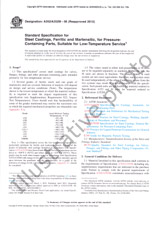We need your consent to use the individual data so that you can see information about your interests, among other things. Click "OK" to give your consent.
ASTM E2089-15(2020)
Standard Practices for Ground Laboratory Atomic Oxygen Interaction Evaluation of Materials for Space Applications
Translate name
STANDARD published on 1.11.2020
The information about the standard:
Designation standards: ASTM E2089-15(2020)
Publication date standards: 1.11.2020
SKU: NS-1013227
The number of pages: 5
Approximate weight : 15 g (0.03 lbs)
Country: American technical standard
Category: Technical standards ASTM
The category - similar standards:
Annotation of standard text ASTM E2089-15(2020) :
Keywords:
ICS Number Code 27.120.30 (Fissile materials and nuclear fuel technology)
Additional information
| Significance and Use |
|
3.1?These practices enable the following information to be available: 3.1.1?Material atomic oxygen erosion characteristics. 3.1.2?An atomic oxygen erosion comparison of four well-characterized polymers. 3.2?The resulting data are useful to: 3.2.1?Compare the atomic oxygen durability of spacecraft materials exposed to the low Earth orbital environment. 3.2.2?Compare the atomic oxygen erosion behavior between various ground laboratory facilities. 3.2.3?Compare the atomic oxygen erosion behavior between ground laboratory facilities and in-space exposure. 3.2.4?Screen materials being considered for low Earth orbital spacecraft application. However, caution should be exercised in attempting to predict in-space behavior based on ground laboratory testing because of differences in exposure environment and synergistic effects. |
| 1. Scope |
|
1.1?The intent of these practices is to define atomic oxygen exposure procedures that are intended to minimize variability in results within any specific atomic oxygen exposure facility as well as contribute to the understanding of the differences in the response of materials when tested in different facilities. 1.2?These practices are not intended to specify any particular type of atomic oxygen exposure facility but simply specify procedures that can be applied to a wide variety of facilities. 1.3?The values stated in SI units are to be regarded as the standard. 1.4?This standard does not purport to address all of the safety concerns, if any, associated with its use. It is the responsibility of the user of this standard to establish appropriate safety, health, and environmental practices and determine the applicability of regulatory limitations prior to use. 1.5?This international standard was developed in accordance with internationally recognized principles on standardization established in the Decision on Principles for the Development of International Standards, Guides and Recommendations issued by the World Trade Organization Technical Barriers to Trade (TBT) Committee. |
We recommend:
Technical standards updating
Do you want to make sure you use only the valid technical standards?
We can offer you a solution which will provide you a monthly overview concerning the updating of standards which you use.
Would you like to know more? Look at this page.




 Cookies
Cookies
